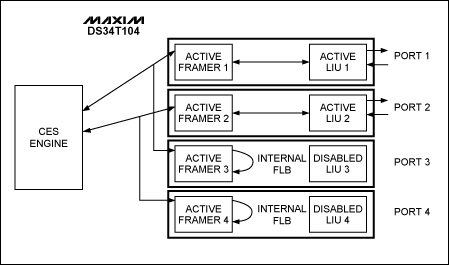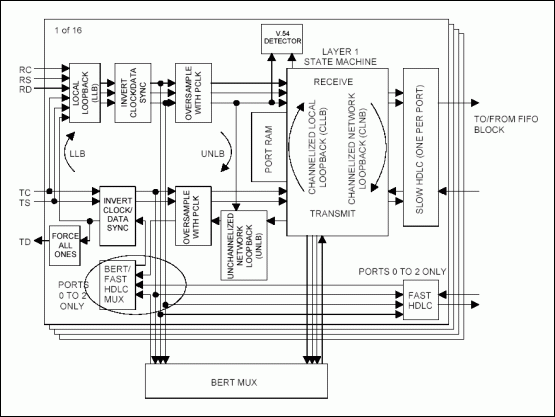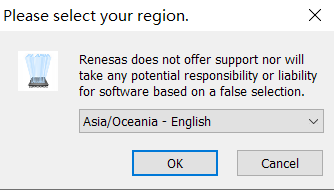Introduction
In many applications, system administrators need to use an operation support system (OSS) for operation and management control of elements in a network. Using OSS, administrators can issue commands to the "Test Head" to enable or disable FDL network loopback. This application note shows how to implement these FDL commands using the DS34T10x family of TDMoP devices.FDL Loopback Command Functions
In a typical application, FDL loopback commands are generated at the Test Head (Figure 1).
Figure 1. FDL Loopback activation and deactivation at the Test Head.
The Test Head is defined as a component in the maintenance system. Whenever a failure in the TDM line is reported, the FDL loopback can be used as a diagnostic tool to determine where the failure occurred. In legacy T1 networks, the TDM line is physically connected to the Test Head so that loopback commands can be issued and the results evaluated.
In a normally functioning network, TDM traffic is terminated at the customer premises equipment (CPE). Consider the example network in Figure 1. When a network impairment is detected, the network is put into maintenance mode; the command from the OSS will be issued through the TDM gateway and then through the ONU or ONT. In this example, the TDM gateway supports circuit emulation services (CES), which means that the TDM gateway is the termination point of CES pseudo wires. All CES traffic is terminated at the TDM gateway. The ONT or ONU can also be a GPON terminal and, therefore, required to terminate GPON traffic. In this scenario, the ONU would be required to terminate both the GPON traffic and the CES traffic transmitted from the TDM gateway. In Figure 1, the ONU is implemented with one of Maxim's TDMoP products. Also shown in this Figure is a smart jack (SJ), which is common in many legacy PDH networks.
Internal Hardware Connections
To implement network loopback as defined in the GR-312-CORE standard, two FDL commands are required.- Network Loopback Activation (00010010 11111111) The bit-oriented command and response message transmitted on the ESF data link will put the SJ in the maintenance state and will loop back received T1 traffic. The SJ will remain in the maintenance state when the transmission of the loopback activation messages ceases. The TDMoP device will monitor bits 9 through 14 (001001) to activate the Loopback command.
- Network Loopback Deactivation (00100100 11111111) The bit-oriented command and response message transmitted on the ESF data link will put the connector in the normal state to pass T1 traffic like a repeater. The connector will remain in the normal state when the transmission of the loopback deactivation messages ceases. Here again, the TDMoP device will monitor bits 9 through 14 (010010) to deactivate the Loopback command.
To implement loopback activation and deactivation, an extra T1 framer is required for each T1 port. As Figure 2 shows, if two T1 ports are implemented in the network, then two additional T1 framers are also implemented for the framer loopback (FLB) application. This example uses a DS34T104, which contains four T1 ports (two for the required T1 ports, and two for FDL loopback support). If 8 T1 ports are required, a DS26401 can be used to provide the additional 8 framers. These additional framers are used for tapping off of the original framers; these framers are used only for loopback activation and deactivation. In Figure 2, a DS34T104 is used to implement two T1 ports to generate TDMoP bundles and provide loopback support.

Figure 2. DS34T104 application example for loopback activation and deactivation support.
In Figure 2, Framer 3 will tap Framer 1 and Framer 4 will tap Framer 2. This configuration must be enabled prior to sending FDL activation and deactivation codes. The driver and the configuration are available by request from Maxim.
To verify this configuration, configure the FMRTOPISM4 register as shown:
Set FMRTOPISM4.FRMR3 = 000 so that FRMR3 source from FRM1Since FDL only works in T1 ESF framing mode, ports 3 and 4 should be configured as noted here:
Set FMRTOPISM4.FRMR4 = 001 so that FRMR4 source from FRM2
Set TCR3.TFM = 0Next, the device is configured for transparent mode in the Transmit Control Register 1.
Set RCR1.RFM = 0
TCR1 = 64h or 60h, depending on whether B8ZS is requiredFramer loopback is then enabled on Framer 3 and Framer 4 by setting Receive Control Register 3.
RCR3.FLB = 1 for Framer 3 and Framer 4The Receive BOC for port 3 and port 4 needs to be programmed to detect N (N = 1, 3, 5, or 7) codes in a row by setting the RBOC register:
RBOC[2:1] = 00 for 1 consecutive BOC code for valid sequence identificationWhen a valid BOC event is detected (as indicated through the setting of RLS7.BD), the RBOC message should be read from the RBOC register. Then based on the RBOC message, loopbacks can be set by using the LMCR register.
RBOC[2:1] = 01 for 3 consecutive BOC codes for valid sequence identification
RBOC[2:1] = 10 for 5 consecutive BOC codes for valid sequence identification
RBOC[2:1] = 11 for 7 consecutive BOC codes for valid sequence identification
LMCR[2:0] = 010In the driver provided by Maxim there is a command code in the _te1DrvCTRL function argument that allows for sending either BOC data:
TE1DCTRL_T1403TXPKTAll communication to the drivers (both internal and external) goes through a simple API in the agent.c and t1e1_interface.c file.
TE1DCTRL_T1403TXBOC
A call to transmit the BOC code would be formatted as follows:
// Call the driver's transmit BOC function
retval &= (*lnPtr->drvCtrl)(DRVREF, TE1DCTRL_T1403TXBOC, ENABLE, (INT)BOC_CODE);A call to discontinue transmitting the BOC code would be formatted as follows: // Call the driver's transmit BOC function
retval &= (*lnPtr->drvCtrl)(DRVREF, TE1DCTRL_T1403TXBOC, DISABLE, NULL);
Conclusion
FDL network loopback activation/deactivation commands are required to be supported in ONU elements. The DS34T10x family of TDMoP devices provides analog loopback features that enable this functionality. When a valid loopback command is received in the BOC, analog loopback can be enabled or disabled accordingly. Having this functionality in the DS34T10x products eliminates the need for an internal SJ to the DS34T10x inside an ONU element.For more information about Maxim's TDMoP product family, please contact the Communications and Timing application support team through the Maxim website or by phone at 01-972-371-6555.
 電子發(fā)燒友App
電子發(fā)燒友App
























評論